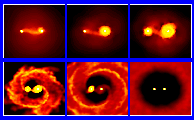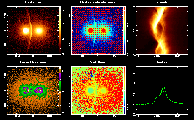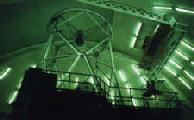
| Physics and Astronomy |
|
| Physics Home | Study here | Our Teaching | Our Research | Our Centres | News | Work here | EMPS |
|
Physics Research
Research groups
See Also
|
||||||||||||||||||||
Back to top
Astrophysics Research
| ||||||||||||||||||||
Star Formation |  |
||
Circumstellar Matter |  |
||
Interacting Binaries |  |
||
Astronomical Computing |  |
||
| | |||
See also |  |
||
Star Formation
How stars form is one of the most fundamental problems remaining in modern astronomy. What determines the masses of the stars? How does material accrete onto the protostar? What happens to the angular momentum of the collapsing protostellar cloud? How do binary stars and clusters of stars form?
At Exeter we use a variety of methods of study the star formation process. We aim to understand the global structure of star formation regions by observing them when they are younger than about 10 million years (this could be termed "stellar archaeology"). We use powerful numerical simulations based on smoothed-particle hydrodynamics to investigate how star form, the structure of their circumstellar disks, and how binaries and clusters of stars originate. Spectropolarimetry and radiative-transfer modelling are used to probe the circumstellar flows in the late-stages of star formation.
More about: Numerical simulations of star formation,
Star formation.
Interacting Binaries
We concentrate on interacting binaries where one of the objects is a super-dense compact object: either a white dwarf, or a neutron star or a black hole. Material is ripped off the (relatively) normal companion star to form a disc around this compact object. This gives us the opportunity to learn about the properties of the compact object, for example, we have a programme for measuring the masses of the black holes. This in turns tells us about how the black holes form, and about the physics of matter at nuclear and super-nuclear densities.
If the compact object is a white dwarf, hydrogen is accreted onto its surface. Eventually the material reaches just the right conditions to burn. The result is a nova explosion, with material being thrown out of the binary into the interstellar medium. The effect this explosion has on the binary is controversial, but we have made the case for one point of view in a series of papers.
More about: Black hole binaries,
Symbiotic binaries.
Circumstellar Matter
Stars lose mass throughout their lifetimes, from the molecular outflows at the earliest evolutionary stages to the last-gasp mass ejections of asymptotic giant branch stars and the cataclysmic explosions of supernovae. Up to 90% of a star's initial mass may be lost in the form of winds, and these outflows play a crucial role in determining the evolutionary paths of the stars themselves and the galaxies in which they exist; providing feedback mechanisms that regulate star formation rates, and returning vast quantities of chemically-enriched material and kinetic energy into interstellar space.
Traditional radiative-hydrodynamical models of stellar mass-loss are one-dimensional, but it is becoming increasingly apparent from observations that a full time-dependent, three-dimensional treatment is necessary. We are using polarimetry and multi-dimensional radiative-transfer to develop a new generation of observational programmes and modeling codes, in order to begin the process of quantifying the detailed structure of circumstellar outflows, relaxing the restrictive assumptions of homogeneity, time-independence, and spherical symmetry. The impact of our research programme is wide-ranging: a better understanding of high-mass star formation, and improved mass-loss rate estimates across the Hertsprung-Russell diagram, will lead to advances in our understanding of galactic evolution, star formation and starbursts, and ultimately the chemical history of the Universe.
More about: Bipolar planetary nebulae,
Colliding winds,
Early-type stars.
Astronomical Computing
We are interested in developing new algorithms for extracting the maximum amount of information from astronomical observations. We are also involved in the development of testing of new data reduction software for the next generation of instruments that will operate at the world's finest observational facilities.
More about: Data Reduction Pipelining,
Open Source Infrastructure,
Optimal extraction,
Spectral Datacubes.
General Information
Personnel
| Project Leaders: | Dr M.R. Bate, Dr T.J. Harries, Prof. T. Naylor. |
| Starlink Programmer: | Dr A. Allan. |
| Contact: | t.naylor@exeter.ac.uk |
Group Facilities
We are the UK's newest Starlink node, and our computing facilities consist of a network of high-specification PCs running linux. Theoretical research is also conducted on supercomputers such as those at the UK Astrophysical Fluids Facility. Our observational programmes are conducted on large ground-based telescopes such as the WHT, the AAT, and UKIRT - and space-based observatories such as HST and XMM.
See Also
- Group Home Page
- Group publications list
- School research-facilities
- School research grant final reports
- Other physics-research at Exeter
